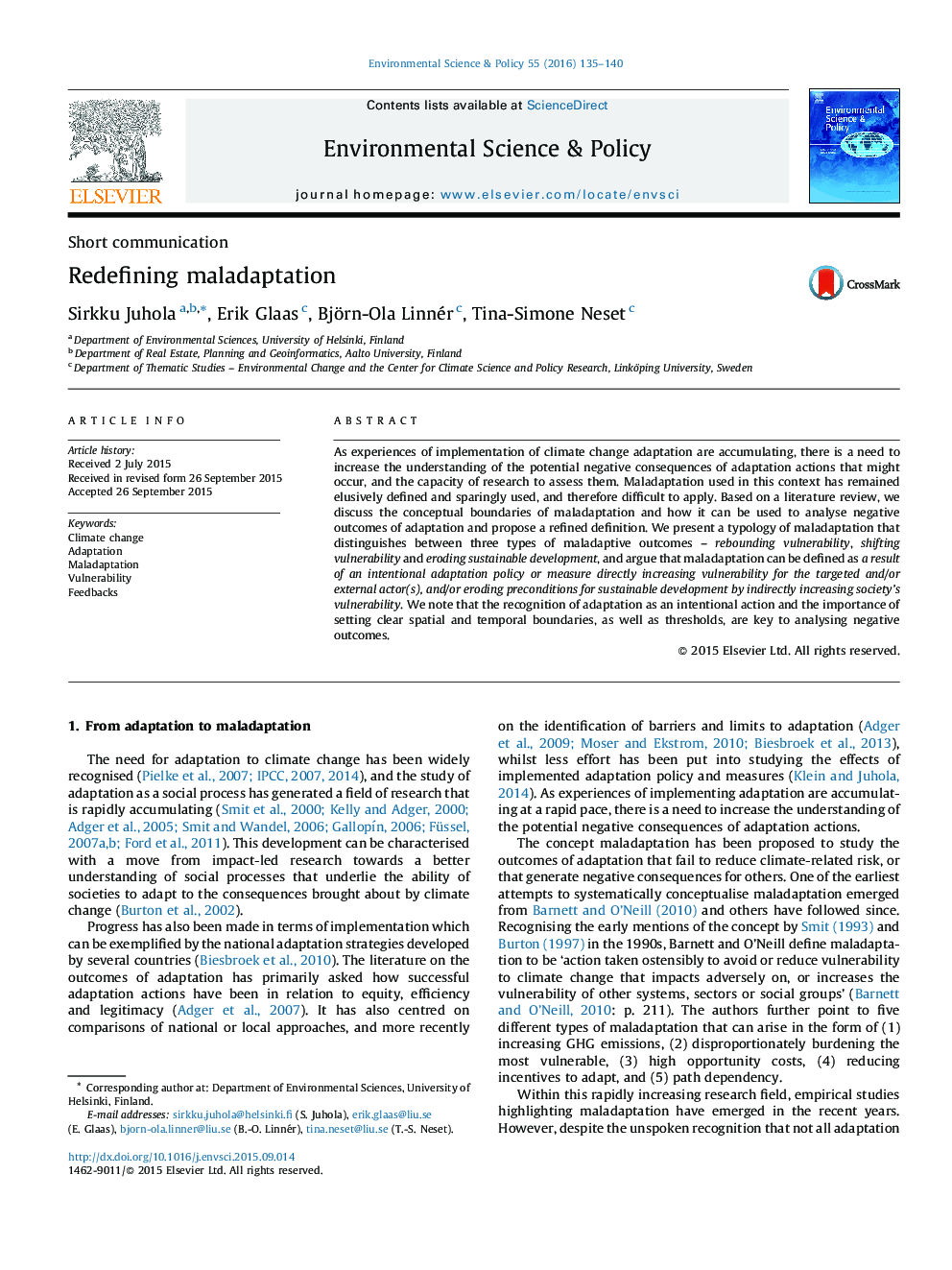| کد مقاله | کد نشریه | سال انتشار | مقاله انگلیسی | نسخه تمام متن |
|---|---|---|---|---|
| 10504559 | 946686 | 2016 | 6 صفحه PDF | دانلود رایگان |
عنوان انگلیسی مقاله ISI
Redefining maladaptation
ترجمه فارسی عنوان
تعریف مجدد ناهنجاری
دانلود مقاله + سفارش ترجمه
دانلود مقاله ISI انگلیسی
رایگان برای ایرانیان
کلمات کلیدی
تغییر آب و هوا، انطباق، سوء تغذیه، آسیب پذیری، انتقادات
ترجمه چکیده
همانطور که تجارب اجرای سازگاری تغییرات اقلیمی در حال جمع شدن هستند، نیاز به افزایش درک پیامدهای منفی بالقوه اقدامات سازگاری که ممکن است رخ دهد، و ظرفیت تحقیق برای ارزیابی آنها وجود داشته باشد. سوءاستفاده در این زمینه، با کمال تعریف و با کمترین استفاده انجام شده است، بنابراین کاربرد آن بسیار دشوار است. بر اساس بررسی ادبیات، ما مرزهای مفهومی ناهنجاری را مورد بحث قرار می دهیم و چگونه می توان آن را برای تجزیه و تحلیل نتایج منفی سازگاری استفاده کرد و تعریف تصفیه شده را پیشنهاد داد. ما نوعی از ناهنجاری را ارائه می دهیم که بین سه نوع نتایج نادرست - بینابینی آسیب پذیری، تغییر آسیب پذیری و ریشه کن کردن توسعه پایدار را بیان می کند و استدلال می کند که ناهنجاری می تواند به عنوان یک نتیجه از سیاست های انطباقی عمیق تعریف شود و یا به طور مستقیم افزایش آسیب پذیری برای هدف و / یا بازیگر خارجی (ها) و / یا پیش شرط های توسعه پایدار را از طریق غیر مستقیم افزایش آسیب پذیری جامعه افزایش می دهد. ما یادآوری می کنیم که شناخت سازگاری به عنوان یک اقدام عمدی و اهمیت تعیین مرزهای فضایی و زمانی و همچنین آستانه ها برای تحلیل نتایج منفی کلیدی است.
موضوعات مرتبط
مهندسی و علوم پایه
مهندسی انرژی
انرژی های تجدید پذیر، توسعه پایدار و محیط زیست
چکیده انگلیسی
As experiences of implementation of climate change adaptation are accumulating, there is a need to increase the understanding of the potential negative consequences of adaptation actions that might occur, and the capacity of research to assess them. Maladaptation used in this context has remained elusively defined and sparingly used, and therefore difficult to apply. Based on a literature review, we discuss the conceptual boundaries of maladaptation and how it can be used to analyse negative outcomes of adaptation and propose a refined definition. We present a typology of maladaptation that distinguishes between three types of maladaptive outcomes - rebounding vulnerability, shifting vulnerability and eroding sustainable development, and argue that maladaptation can be defined as a result of an intentional adaptation policy or measure directly increasing vulnerability for the targeted and/or external actor(s), and/or eroding preconditions for sustainable development by indirectly increasing society's vulnerability. We note that the recognition of adaptation as an intentional action and the importance of setting clear spatial and temporal boundaries, as well as thresholds, are key to analysing negative outcomes.
ناشر
Database: Elsevier - ScienceDirect (ساینس دایرکت)
Journal: Environmental Science & Policy - Volume 55, Part 1, January 2016, Pages 135-140
Journal: Environmental Science & Policy - Volume 55, Part 1, January 2016, Pages 135-140
نویسندگان
Sirkku Juhola, Erik Glaas, Björn-Ola Linnér, Tina-Simone Neset,
